I you are looking for a series of picture books that share the delightful fun and magic of each season with your preschooler...Author, Debbie Estrem has a little collection for you.
Winter Wonderland
Written by Debbie Estrem
For ages 2 -5
Coming soon from Halo Publishing.
 A Time for Fall Fun - Coming Soon from Halo PublishingIt's Summertime!
A Time for Fall Fun - Coming Soon from Halo PublishingIt's Summertime!

*Picture book for preschool through first grade
*Little girl and her cat as main characters
*Rating: Brownie and Pearl: Take a Dip is a cute, summer book. I wouldn’t say it’s one of the best, but it sure captivated my 10-month-old daughter’s attention and got her “talking.” I would say fans of the series will like it. I chose it for my tribute to the end of the summer!
Short, short summary:
Brownie, a little girl, and her cat Pearl are hot! They decide to take a dip (which some kids will learn means GO SWIMMING!). They fill up their backyard pool, get their sunglasses, and test the water. Pearl winds up doing more than just testing the water. For those of us who know anything about cats–well, Pearl is not too happy. It all ends well when they decide to dry off in the sun.

The illustrations by Brian Biggs are the best part of this book–very, very, very nice (as Rylant says).
So, what do I do with this book?
1. For a fun “dictionary” type of activity with small children, consider asking them (BEFORE reading the book) what is a dip? They might know dip of ice cream or dip a washcloth into the bath water. For all the definitions, look in a dictionary or use my favorite: www.dictionary.com. Then share the book with children, and ask them, “Okay, what else can dip mean?” Then ask students to use DIP in a sentence–any way they want–and draw a picture to go with it.
2. Talk about character feelings with this book, especially since the illustrations are so big and bright. How are Brownie and Pearl feeling at the beginning of the book? How does Pearl feel when she falls into the pool? Why does Brownie giggle? And so on. You can take this activity a step further by asking, “Have you ever felt this way? When?”
3. Children will most definitely want to share a swimming story or pet story with you after sharing this book–either at home or at school. If you are a teacher with a room full of children with stories, do think, pair, share. First they all think of a related story, next they share it with a partner. That way, everyone gets to tell their story without taking too much class time. At home, of course, you have more time with less children. 
Today at PBS Booklights I’m sharing thirteen chapter books that take place during the summer. I tried to include a mix of styles, genres, and characters, but in general, I went with a lighter tone in the books I selected. There were many more titles that could have been included, and I think I’ll do one more list of tween/teen selections. I hesitate to commit because making each of these lists took a long time — much longer than I thought it would.
Anyway, last week I wondered here if there were an ideal way to indicate race and culture in very short reviews. This week I come with a new problem that perhaps you — yes, you, author person — can solve: I couldn’t find many summer stories that feature kids of color. Can someone get on this, please?
Oh, and here’s last week’s list of Summer Picture Books again — because, as I mentioned, it took a long time to make so I need to get like, double credit for it.
 Theresa Breslin wrote this book based on real experiences from when a group of prisoners attempted to break out of Alcatraz in the late 1940s. The story is told from the point of view of Marty King, a young, simple man who wants to grow tomatoes in the warm sun of Mexico and somehow manages to get into bad situations that ultimately land him in Alcatraz. Because he is small, some other prisoners convince him (as if he really had a choice) to help prepare for a break out by crawling through an air vent and making an imprint of a key on a bar of soap. Without ruining the story, Marty shares his insights into the legendary prisoners at Alcatraz and his own life.
Theresa Breslin wrote this book based on real experiences from when a group of prisoners attempted to break out of Alcatraz in the late 1940s. The story is told from the point of view of Marty King, a young, simple man who wants to grow tomatoes in the warm sun of Mexico and somehow manages to get into bad situations that ultimately land him in Alcatraz. Because he is small, some other prisoners convince him (as if he really had a choice) to help prepare for a break out by crawling through an air vent and making an imprint of a key on a bar of soap. Without ruining the story, Marty shares his insights into the legendary prisoners at Alcatraz and his own life.
The first element that stuck out to me was Breslin’s use of structure in this story. We first meet Marty after he’s in Alcatraz and subsequently learn how he grew up with his Ma in Chicago and, in between, how he gets bullied into the escape party and how he got into Alcatraz to begin with. The next element Breslin exceeds it that her use of voice. We can picture Marty as he speaks, through the way he speaks, as well as Marty’s cohorts and fellow prisoners. We sense who they are simply through their dialogue. Because of these two elements, Breslin presents an entertaining and highly impactful story in slightly more than 80 pages.
Now this book is not bilingual and we do not carry it at bububooks (yet). However, we wanted to share it with you because not only is Theresa Breslin an amazing author, but also because the publisher of this particular book is special to us. They are known as Barrington Stoke and are located in Great Britain. Barrington Stoke uses its own font and paper that are designed to help dyslexic people read. The font, with its “a”s and “g”s shaped more like how we write them rather than type them, is also useful to English Language Learners who may need to reconcile the difference between handwritten English letters and typed English letters. Further, Barrington Stoke uses readers as consultants on titles before they’re published. If you’re interested in becoming a consultant, email them at [email protected] or visit www.barringtonstoke.co.uk.
For more information on Theresa Breslin and her work, please visit: http://www.theresabreslin.co.uk/






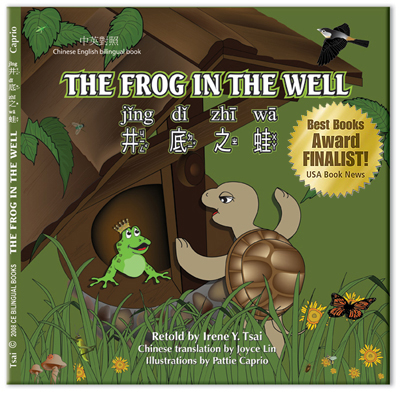
The cover of The Frog in the Well
The Frog in the Well retells a Chinese idiom. Chinese idioms tend to be four characters long and paint a moral teaching. The frog that lives in a well believes the well encompasses the entire world and that he understands it better than anyone else. One day the frog meets a sea turtle that introduces the wide, deep ocean full of much more life than the well. From this experience, the frog realizes a world exists outside the well.
New author Irene Tsai highlights the moral lesson that one should not be narrow-minded and, instead, be aware of the “ocean of knowledge for him to learn.” She does so in this beautifully and clearly illustrated book—by Pattie Caprio—that includes both traditional and simplified characters along with pinyin and zhuyin. Irene also succeeds in offering imagery for the life the frog is living, something that will certainly capture the attention and imagination of children.
Indeed, The Frog in the Well has won the Reader Views 2009 Reviewers Choice Award and has received rave reviews that are copied below.
“What a delightful book! It has a meaningful message, and the illustrations are charming! My father attempted to teach me Chinese when I was a child. I would have loved this book! I know that The Frog in the Well will be enjoyed by aspiring language students, their parents, and teachers.”
–Dominie Soo Bush, Writer and Educator, FL
“Irene Tsai tells stories that speak to readers of all ages. She has a unique ability to convey classic Chinese stories by using language and tone that children today can appreciate. She expands cultural boundaries and provides an avenue for nurturing your child’s emotional development.”
–Harsh K. Trivedi M.D., Child and Adolescent Psychiatrist
Brown Medical School, RI
“The Frog in the Well is both beautifully written and illustrated. The story of how the frog views his world will jump off the pages for children while educating them about Chinese culture and language.”
–Tom Watkins, Michigan State Superintendent of Schools (2001-2005)
Honorary Professor, Mianyang University
The Frog in the Well is now available at www.bububooks.com. Check it out today!







Colorin Colorado
Below is an article taken from Colrín Colorado, a bilingual (Spanish and English) website for families and educators of English Language Learners. It offers five tips for helping your child continue to learn over the summer break. Scroll down for the English version. Enjoy!
Cinco consejos gratuitos y sencillos para el aprendizaje de verano
Por: Brenda McLaughlin y Jane Voorhees Sharp (2008)
Existen estudios bien documentados sobre cuánto de lo ya aprendido pierden los niños durante el verano. Harris Cooper de la Universidad Duke observa que “en general, durante el verano los niños experimentan una pérdida promedio de lo aprendido en lectura y matemáticas que equivale a un mes de aprendizaje” (1996).
La cuestión es que los niños no tienen por qué perder nada de lo aprendido durante el verano. En realidad, usted puede alentar a su hijo a disfrutar del verano y a aprender siguiendo estos cinco consejos gratuitos y sencillos. ¡Pruébelos!
1. Leer todos los días
Estudios de investigación
A nivel de la escuela media, leer cuatro o cinco libros durante el verano influye de manera positiva en el nivel de lectura que puede alcanzar el niño en otoño, comparable con la asistencia a la escuela de verano. (Kim, 2004)
Sugerencias
Lleve a sus hijos a la biblioteca con frecuencia y permítales que escojan sus propios libros. Escuchen libros en audio. Suscríbanse a una revista. Túrnense para leerle el uno al otro. Permítales a los niños quedarse despiertos hasta media hora más si es para leer.
2. Usar las matemáticas todos los días
Estudios de investigación
El área donde se registra la mayor pérdida que sufren los niños durante el verano es en el área de los cómputos matemáticos, a un nivel de 2.6 meses promedio de aprendizaje. (Cooper, 1996)
Sugerencias
Practiquen las tablas de multiplicar aumentando 7 veces (o hasta 8 ó 9) el valor de cada punto en un juego de baloncesto. Pídales a los niños que pidan cambio en la ventanilla de autoservicio. Enséñeles a los niños cómo ingresar en www.coolmath.com en inglés) para jugar juegos de matemáticas. Invente problemas de matemáticas cuando viajan en automóvil o durante la cena.
3. Salir a jugar
Estudios de investigación
Los programas de actividad física intensa tienen efectos positivos en los logros académicos, además de mayor concentración, mejores calificaciones en pruebas de matemáticas, lectura y escritura, y menos casos de mal comportamiento. (Journal of School Health, 1997)
Sugerencias
Busque opciones para que su hijo haga actividad durante 60 minutos por día. Sugiérale pasear el paseo del vecino, ir a nadar, jugar al badminton o al fútbol, salir a caminar o andar en bicicleta en familia. Busque formas seguras y divertidas de salir a jugar durante todo el año. Visite los sitios de Internet Los niños en su casa, PBS Padres, y los Centros para el Control y la Prevención de Enfermedades para consultar más ideas y información en español.
4. Escribir todas las semanas
Estudios de investigación
La mayoría de los estudiantes de primer año que ingresan en instituciones postsecundarias para cursar un título de grado deben tomar clases de refuerzo de escritura más que clases de lectura. (NCES 2003)
Sugerencias
Pídale a su hijo que les escriba una carta por semana a sus abuelos, parientes o amigos. Anímelo para que escriba un diario de verano. Pídale que escriba la lista de las compras para la familia. Organice un proyecto del amigo invisible por carta para adultos y niños en su iglesia o comunidad.
5. Hacer una buena acción
Estudios de investigación
Los estudiantes aprenden más y “actúan” menos cuando participan en actividades que ayudan a su desarrollo socioemocional, como el servicio comunitario. (The Collaborative for Academic Social and Emotional Learning, 2004)
Sugerencias
Incentive a su hijo para que ayude a sus vecinos o amigos. Puede ofrecerse como voluntario de un grupo local o participar de un proyecto educativo de servicio. Sugiérale que reserve parte de su asignación para donarla. Miren juntos el sitio de Internet Big Help de Nickelodeon (en inglés) y el sitio de Parent Link Rhode Island (en español) para tener más ideas.
Five Free and Easy Tips for Summer Learning: Research Pointers and What You Can Do
By: Brenda McLaughlin and Jane Voorhees Sharp (2005)
Research about how much children lose ground over the summer is well documented. Harris Cooper of Duke University notes, “Overall, children experience an average summer learning loss across reading and mathematics of about one month” (1996).
The thing is, though, kids don’t have to lose over the summer. In fact, you can encourage your child to have a summer of fun and learning with these five free and easy things to do. Try them out!
1. Read Every Day
The Research
At the middle school level, reading four to five books over the summer has a positive impact on fall reading achievement comparable to attending summer school (Kim, 2004).
Suggestions
Take your kids to the library often and let them choose which books to check out. Listen to books on tape. Subscribe them to a magazine. Take turns reading to each other. Allow your kids to stay up a half hour later at night as long as they’re reading.
2. Use Math Every Day
The Research
The largest summer learning losses for all children occur in mathematical computation, an average of 2.6 months (Cooper, 1996).
Suggestions
Practice the multiplication tables by making each point in a basketball game worth 7 points (or 8 or 9). Ask your kids to make change at the drive-thru. Show your child how to go to Cool Math to play math games. Make up math word problems in the car and at the dinner table.
3. Get Outside and Play
The Research
Intense physical activity programs have positive effects on academic achievement, including increased concentration; improved mathematics, reading, and writing test scores; and reduced disruptive behavior (Journal of School Health 1997).
Suggestions
Find ways to ensure your child is active for 60 minutes each day. Have him or her walk the neighbor’s dog, go swimming, play badminton or soccer, take walks, or go for family bike rides. Look for safe, fun ways to play outside together year-round. Go to Family Corner Magazine and PBS Parents for more ideas.
4. Write Every Week
The Research
More freshmen entering degree-granting postsecondary institutions take remedial writing courses than take remedial reading courses (NCES 2003).
Suggestions
Ask your child to write a weekly letter to his or her grandparents, relatives, or friends. Encourage him to keep a summer journal. Have her write the family’s grocery list. Organize a secret pal writing project for adults and kids at your church or in your community.
5. Do a Good Deed
The Research
Students learn better and “act out” less when they engage in activities to aid in their social-emotional development, such as community service (The Collaborative for Academic Social and Emotional Learning, 2004).
Suggestions
Encourage your child to help out neighbors or friends. He or she can volunteer with a local group or complete a service learning project. Suggest that your child set aside part of his allowance for charity. Look at Nickelodeon’s Big Help web site together for more ideas.
Adapted from a presentation by Brenda McLaughlin, Director of Research and Policy, Center for Summer Learning, Johns Hopkins University and Jane Voorhees Sharp, Office of Early Care and Education, New Jersey Department of Human Services.







Cover of We are a Rainbow/Somos un arco iris
Nancy Maria Grande Tabor writes bilingual Spanish/English books for children. Some of her titles include Somos un arco iris / We Are a Rainbow and Albertina anda arriba: el abecedario / Albertina Goes Up: An Alphabet Book. An American, Tabor grew up mostly in Mexico. She now teaches Kindergarten in northern California.
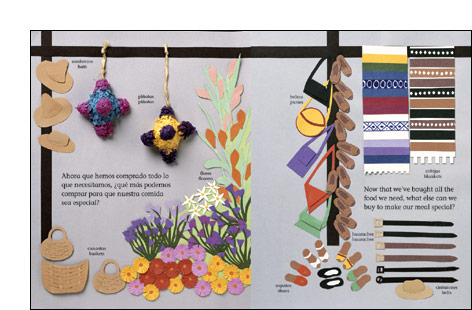
Inside look to A Taste of the Mexican Market/El gusto del mercado mexicano
Nancy Tabor was one of the first bilingual teachers in her school. She discovered there existed very few bilingual books to help her teach her class. Indeed, because the thought of bilingual education was so new, Tabor struggled to find any resources or even support as she developed her teaching program. One night, Tabor expressed her frustrations to her daughter who replied, “Why don’t you write your own book?” That same night, Tabor sat down and wrote her own book. She cut out her art from construction paper. And an author was born!
Tabor went on to write several more books, creating her own beautiful and colorful artwork for each. A huge fan, bububooks offers all of Tabor’s books.
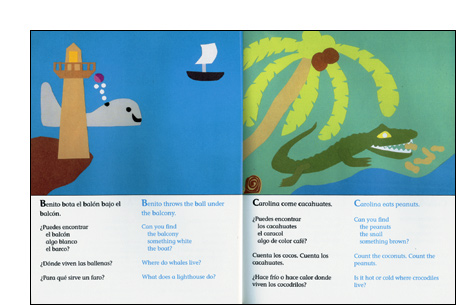
Inside look to Albertina Goes Up: An Alphabet Book/Albertina anda arriba: el abecedario
*The information provided in this blog was gathered from a presentation Tabor gave at the Multicultural Children’s Literature Conference in San Francisco, March 2009.






Summer break is in full swing. We’ve listed our top ten books for summer reading below as well as Laura’s review of each of them. Buy them at www.bububooks.com for your kids’ enjoyment during the summer break!
1. My First Book of Proverbs/ Mi primer libro de dichos
Brilliantly illustrated, this book offers insight into Mexican proverbs or “kisses of language.” With an introduction by Sandra Cisneros, this book is a hit with parents and children alike!
2. Somos un arco iris / We Are a Rainbow
This book openly discusses the issues children face as they get to know each other’s cultures. I like it because Nancy María Grande Tabor focuses on cultural similarities and differences as well as the misunderstandings and happiness friends experience together as they grow. Beautifully illustrated by her own construction paper cutouts, this book serves as a great introduction into building cultural identities.
3. Celebrations / Celebraciones: Holidays of the United States of America and Mexico / Dias feriados de los Estados Unidos y Mexico
Another one of my favorites, Tabor highlights the various holidays in America and Mexico, their importance and how they are celebrated.
4. In My Family/En mi familia
Carmen Lomas Garza brings another fascinating book to us. She takes her readers through life with her family ranging from earaches to cooking to special days. Included with her magnificent paintings, this book takes us into Latino culture as experienced by Garza.
5. Cincuenta en la cebra: contando con los animales / Fifty on the Zebra: Counting with the Animals
This book and #6 are fantastic interactive books. Using her trademark construction paper artwork, Tabor offers an opportunity for you to practice the alphabet (in Spanish AND English) and counting with your child. On each page, Nancy Tabor introduces a letter/number followed by questions such as, “Can you find two candles?” and “Is if a fat cat or a skinny cat?” These books will keep you and your child occupied for hours!
6. Albertina anda arriba: el abecedario / Albertina Goes Up: An Alphabet Book
See #5.
7. The Woman who Outshone the Sun/La mujer que brillaba aún más que el sol
Adapted from a Mexican folktale, this story shares the importance of treating others with kindness. With a lesson that transcends various cultural differences throughout the world, this book offers a folktale most American children will never know. Its beauty in the story is also reflected in the artwork.
8. Angel’s Kite/ La estrella de Angel
I love this story because it is magical. Alberto Blanco draws you in, making you follow the kite with your whole heart, eager to see what happens. And the ending just makes you happy!
9. Baby Rattlesnake/Viborita de cascabel
Baby Rattlesnake is a Native American tale that offers valuable lessons for children. I love it because it illustrates its theme so clearly and colorfully. This story is one of my favorite’s to read out loud to children.
10. Laughing Tomatoes and Other Spring Poems/Jitomates Risueños y otros poemas de primavera
While I love all four of the poem books by Francisco Alarcón, I think this one is my favorite because springs if my favorite season. In this book, Alarcón shares poems about spring, great food, holidays, fruits, gardens and his beloved grandma. Each poem works into its structure colorful illustrations. I highly recommend all four books.
There you have it. The Top 10 books we like for the summer. Feel free to email us for any other recommendations at [email protected]. Enjoy your summer!













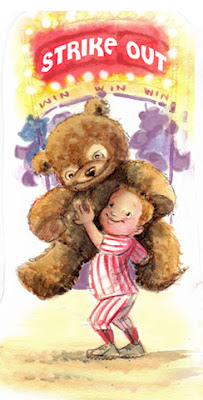

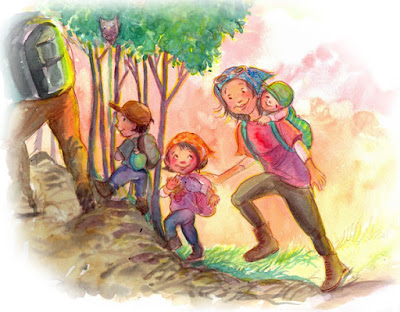













I'm on it! I'm on it!
Seriously: I started a Middle Grade novel this week -- nervously, I don't really know what I'm doing -- but so far it's fun.
I have a new award for you here.